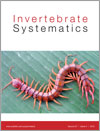IS13019Stable phylogenetic patterns in scutigeromorph centipedes (Myriapoda : Chilopoda : Scutigeromorpha): dating the diversification of an ancient lineage of terrestrial arthropods
The 95 species of house centipedes are survivors of more than 400 million years of evolutionary history. Adding new molecular data for species from previously unsampled tropical regions, the relationships of this ancient group proved to be remarkably stable to alternative methods of analysis. The best-fit model of diversification rate for these centipedes is consistent with them being ‘living fossils’.




